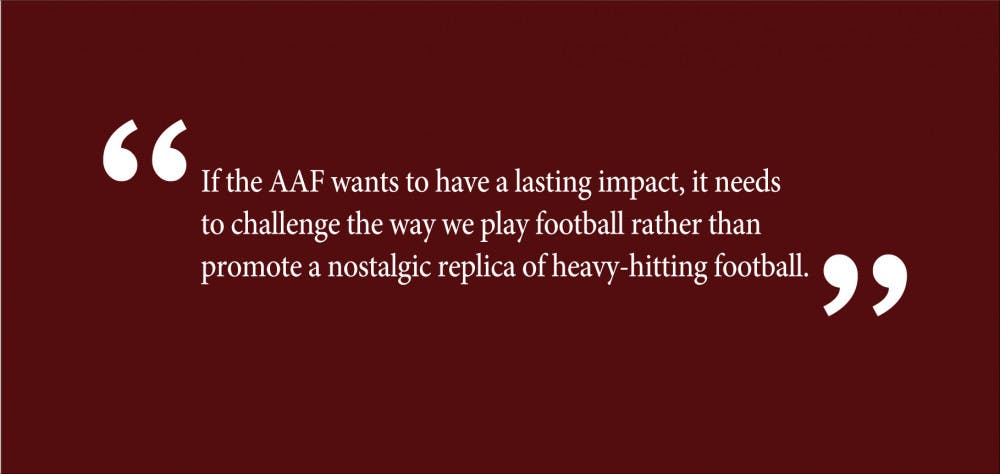CFL. USFL. PPF. IFL. If you’re anything like the vast majority of Americans, these acronyms mean nothing to you. If, however, you have way too much time on your hands, then you might know that these are the football organizations outside of the iconic National Football League. Now there’s one more to add into the mix, and we should all be paying attention.
The newly formed Alliance of American Football kicked off its debut game just five days after this year’s Super Bowl. The AAF is aiming to be a spring league that can hopefully maintain a high enough level of play to become relevant and attract talented NFL hopefuls. But this fledgling league is not attempting to replicate the NFL. Instead, with the experimental latitude of a new league, the AAF has been unabashedly innovative — it is perfectly poised to have a lasting impact on how football is played.
The AAF has been forward thinking in every way. Its main focus is on producing quality football by recruiting the best coaches possible, which includes hiring three talented female coaches. Moreover, as the dangers of football are becoming more apparent — chronic traumatic encephalopathy, irreparable joint damage, among other widespread injuries — we need to change how we play and think about the game. The AAF has several rules that the NFL would be wise to imitate:
I. No kickoffs. Kickoffs have been shown to be the most dangerous play, with a concussion rate over double that of a normal play. Instead of a kickoff, every AAF possession begins on the offensive team’s 25 yard line.
II. Limitations on blitzing. No more than five players can blitz at once, hopefully reducing the chance of a season-ending injury for quarterbacks. Further, the rules don’t seem to limit the defensive line’s ability to get a pass rush.
III. Mandatory two-point conversions. Let’s be honest, nobody wants to watch kickers make an extra point. Field goals, the extra point’s older brother, are exciting because they usually occur in make-or-break moments, while extra points merely slow down the game. The AAF’s rule forces teams to keep quarterbacks on the field for two point conversions, which should result in more trick plays.
IV. Faster play. The AAF’s 35-second game clock and sparse ad breaks should alleviate the stigma of football as a multi-hour commercial interrupted occasionally by players running around with the ball.
V. New overtime rules. Who else was frustrated that the American Football Conference championship matchup was essentially won by a coin flip? Star Kansas City Chiefs’ QB Patrick Mahomes didn’t even get a chance to step on the field in overtime. New overtime rules guarantee both teams get a possession in overtime.
VI. Sky judge. With the coolest name of any officiating position in sports, the sky judge provides a safeguard against referees making incorrect calls. Having some sort of sky judge could have avoided the Saints-Rams pass interference controversy that decided the National Football Conference championship game.
VII. Replacement for onside kicks. Last season’s success rate for an onside kick in the NFL was a meager eight percent. Onside kicks are basically decided by how the ball bounces, so the AAF came up with a far more exciting — and less arbitrary — alternative. Teams get the ball on their own 28-yard line and have to get at least 12 yards on a scrimmage play. Teams can only attempt this when they are down more than 17 points or in the last 5 minutes of the game.
These aggressive changes demonstrate the AAF’s desire to protect its players and make the game more exciting for fans. Along with these new on-field rules, the AAF is also focused on becoming increasingly transparent. A new policy allows networks to mic up coaches and even refs — fans are able to hear the decision-making process behind some of the most important calls in the game.
While I question the AAF’s ability to showcase players who will actually make an NFL roster, these rule changes should absolutely affect how NFL football is played. There is a precedent for smaller leagues to have a big impact on professional play. The XFL was the first league to broadcast from a skycam suspended on wires — now a staple of any NFL game. The NFL, similarly, adopted instant replay and the two-point conversion from the United States Football League.
My one complaint with the AAF is its gladiatorial celebration of big hits. During opening weekend, Shaan Washington hit Mike Bercovici hard enough to send his helmet flying. Twitter blew up, and the AAF got an undeniable surge in popularity. But in the long term, commoditizing players’ health will not work. I’m not saying the AAF should attempt to fully legislate out big hits, but the league should be wary of allowing these helmet-flying hits. If the goal of the AAF is to make a quick buck, then a spectacle like this might prove effective. However, if the AAF wants to have a lasting impact, it needs to challenge the way we play football rather than promote a nostalgic replica of heavy-hitting football. Keep your eyes on the AAF. Soon enough, the NFL might be looking to them for innovation.
Kshitij Sachan ’22 can be reached at kshitij_sachan@brown.edu. Please send responses to this opinion to letters@browndailyherald.com and other op-eds to opinions@browndailyherald.com.





